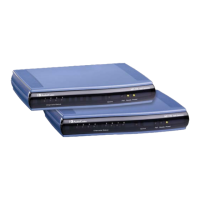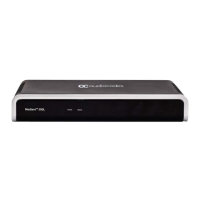Version 7.2 193 Mediant 1000B Gateway & E-SBC
User's Manual 14. Media
Note:
• The device is always ready to receive DTMF packets over IP in all possible
transport modes: INFO messages, NOTIFY, and RFC 2833 (in proper payload
type) or as part of the audio stream.
• To exclude RFC 2833 Telephony event parameter from the device's SDP, set the
'Declare RFC 2833 in SDP' parameter to No.
• You can use the following parameters to configure DTMF digit handling:
√ FirstTxDTMFOption, SecondTxDTMFOption, RxDTMFOption,
RFC2833TxPayloadType, and RFC2833RxPayloadType
√ MGCPDTMFDetectionPoint, DTMFVolume, DTMFTransportType,
DTMFDigitLength, and DTMFInterDigitInterval
14.3.4 Configuring RFC 2833 Payload
The following procedure describes how to configure the RFC 2833 payload through the
Web interface:
To configure RFC 2833 payload:
1. Open the RTP/RTCP Settings page (Setup menu > Signaling & Media tab > Media
folder > RTP/RTCP Settings).
2. Configure the following parameters:
• 'RTP Redundancy Depth' (RTPRedundancyDepth) - enables the device to
generate RFC 2198 redundant packets.
• For Gateway application only: 'Enable RTP Redundancy Negotiation'
(EnableRTPRedundancyNegotiation) - enables the device to include the RTP
redundancy dynamic payload type in the SDP, according to RFC 2198.
• 'RFC 2833 TX Payload Type' (RFC2833TxPayloadType) - defines the Tx RFC
2833 DTMF relay dynamic payload type.
• 'RFC 2833 RX Payload Type' (RFC2833RxPayloadType) - defines the Rx RFC
2833 DTMF relay dynamic payload type.
• 'RFC 2198 Payload Type' (RFC2198PayloadType) - defines the RTP redundancy
packet payload type according to RFC 2198.
3. Click Apply.
14.3.5 Configuring RTP Base UDP Port
You can configure the range (pool) of local UDP ports from which the device allocates
ports to media (RTP, RTCP, and T.38) channels (legs). The maximum range of UDP ports
is from 6,000 through to 64,000.
The consecutive port offset from the RTP port for RTCP and T.38 traffic is one and two,
respectively. For example, if the voice session uses RTP port 6000, the device allocates
ports 6001 and 6002 for RTCP and T.38, respectively. However, you can configure the
device to use the same port for RTP and T.38 packets, by configuring the T38UseRTPPort
parameter to 1.
Within the port range, the device allocates the UDP ports per media channel (leg) in
"jumps" (spacing) of 10. For example, if the port range starts at 6000 and the UDP port
spacing is 10, the available ports are 6000, 6010, 6020, 6030, and so on. Within the port
range, the device assigns these ports randomly to the different media channels. For
example, it allocates port 6000 to leg 1, port 6030 to leg 2, and port 6010 to leg 3.

